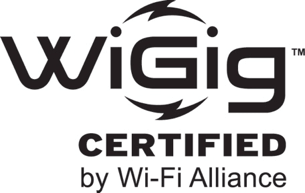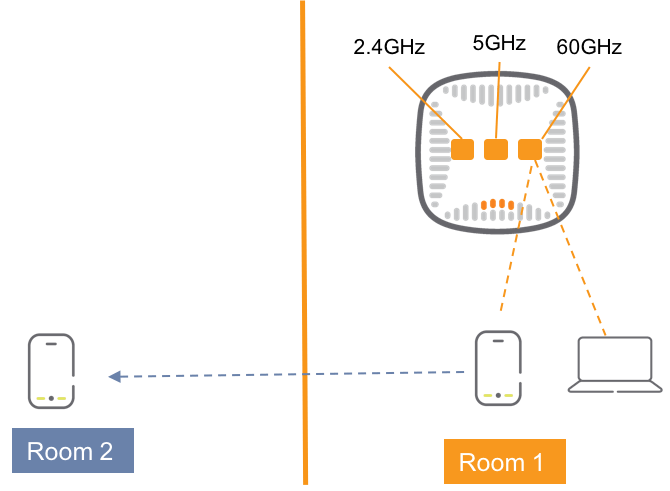
After years of preparation, the Wi-Fi Alliance is planning to launch the WiGig CERTIFIED - 802.11ad certification program by the end of 2016. Like many new technologies at their debut, there are always some advocates and conservatives. For advocates, the WiGig certification will set the standard and drive the product development and market adoption; for conservatives, this will be just another standard and its future fate is still very skeptical. So, how should the WLAN industry take it? Let's take a look.
What is WiGig?
WiGig, the new 802.11ad technology, operates on the unlicensed 60GHz spectrum and delivers theoretical data rates up to 7Gbps. Due to the nature of high-frequency spectrums, it provides ultra fast multi-gigabit data rates but at a limited range of about 30 feet (802.11n and 11ac are able to operate in the range of hundreds of feet and beyond). It can't penetrate walls very well but the wave will be reflected back to WiGig capable devices. By leveraging beam forming, this allows devices within range to be connected and transmitting/receiving data at a blazing fast speed.
What are the foreseeable use cases?
Now we know how fast WiGig can go and its limited range. How can we use it commercially at home or in the enterprise environment? The initial thought of many advocates was to position WiGig for a niche market. At home, WiGig can be used to replace cables between devices, enabling the always-on device connection and file transferring at a blink of eyes; videos/movies are downloaded in a few seconds or minutes, rather than hours; in the workplace, the ultra fast data speed is perfect for video conferencing, screen mirroring and the cable-free docking station. Vendors like HP Inc., Dell and Lenovo have started making WiGig docking stations. However, beyond the cable-free and file sharing use cases, the wireless industry has been exploring opportunities to using WiGig as a complement for Wi-Fi connections.
How to use it with Wi-Fi?
With the availability of 802.11ac in the 5GHz band and the widening channels, free and clean spectrum is running out. The rapid growth of client device numbers is forcing the Wi-Fi industry to explore opportunities to gain more clean spectrums to support the rising device density. The 60GHz band is still a greenfield area and would be a very attractive option to provide more free spectrums for wireless devices and increase the system capacity.
Some may think the limited range of WiGig makes it less appealing or not usable for wireless access for mobile devices. However, in real-life deployment in high-density environments, access points are deployed often within 30 feet or less of any client to ensure the best connection. WiGig can certainly be a great wireless option for high-density environments.
Another concern for Wi-Fi vendors is the client device availability. Like 802.11ac Wave 2, when Wave 2 technology was first introduced to the market, we still only saw a few Wave 2 capable devices that are able to take advantage of the MU-MIMO. However, with the commitment of the chipset and Wi-Fi vendors, we have started to see the Wave 2 device market getting more and more mature. In the WiGig space, device vendors have begun to ship a small number of WiGig devices in 2016. We expect to see more WiGig devices, such as laptops and tablets, available by the end of 2016, followed by WiGig smartphones around 2018. Once the Wi-Fi Alliance introduces the certification program, it surely will drive the WiGig adoption in greater numbers.
The tri-radio Wi-Fi
The Wave 2 adoption path also applies to the WiGig technology; with Wi-Fi Alliance's WiGig certification and chip vendors' commitment to the development of tri-radio (2.4/5/60 GHz) chipsets, industry pioneers are driving the market to an ultra high-speed multi-gigabit tri-radio wireless with support for both Wi-Fi and WiGig technologies. With three radios integrated into one access point, the client can connect to any of the radios for the best user experience. For example, the client can connect to WiGig in a room for super fast connection. Once the client moves away from the room or when an object (e.g. a person, wall) is between the AP and the client, the connection will be automatically and quickly switched to 802.11ac or 802.11n to keep the consistent data transmission (See Figure 1). Interference between radios can be minimized with well designed 802.11ad antenna arrays, especially when the usage is for discrete high-throughput cells rather than ubiquitous coverage.

Figure 1: The move of the client and the radio connection in the WiGig environment
With several models of multi-gigabit access aggregation switches available today including the Aruba 5400R and 3810 that incorporate HPE Smart Rate ports, customers can prepare their wired networks today to be ready for today's 802.11ac multi GigE APs (Aruba 330 Series) and for the future when APs are available with WiGig support that will drive the need for aggregation speeds from 2.5GigE to 5GigE while leveraging existing Cat 5e/Cat 6 cabling.
Conclusion
WiGig is on its way to join the Wi-Fi family to power the mobile-first environments of tomorrow. While the use cases of WiGig are yet to be extended and proven, vendors in the wireless ecosystem are getting ready to surf on the new wave of 802.11ad technology. The blazing fast Wi-Fi is only a few steps away.




